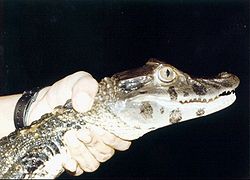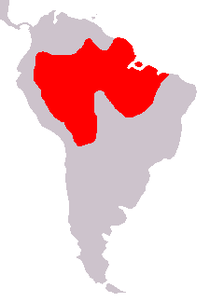- Black caiman
-
Black caiman 
Juvenile Black Caiman Conservation status Scientific classification Kingdom: Animalia Phylum: Chordata Class: Reptilia Order: Crocodilia Family: Alligatoridae Genus: Melanosuchus Species: M. niger Binomial name Melanosuchus niger
Spix, 1825The black caiman (Melanosuchus niger) is a crocodilian. It is a carnivorous reptile that lives along slow-moving rivers and lakes, in the seasonally flooded savannas of the Amazon basin, and in other freshwater habitats in South America. Once common, it was hunted to near extinction primarily for its commercially valuable hide. It is now listed as Conservation Dependent.[1]
Contents
Appearance
The black caiman has a bony ridge over brown eyes, and black, scaly skin. The skin coloration helps with camouflage during its nocturnal hunts, but may also help absorb heat (See thermoregulation). Mothers on guard near their nests are tormented by blood-sucking flies that gather around their vulnerable eyes leaving them bloodshot.
Small black caiman can be distinguished from large spectacled caiman by their proportionately larger head and shorter tail, as well as by the color of the jaw, which is light colored in the spectacled caiman and dark with three black spots in the black caiman.
Size
The black caiman is one of the largest reptiles. It is the largest predator in the Amazon basin and possibly the largest member of the family Alligatoridae. Most adult black caimans are 3 to 4.26 metres (9.8–14 ft) in lengths, with old males rarely growing larger than 5 metres (16 ft). The black caiman broadly overlaps in size with the American alligator, although it is on average larger at maturity. In some areas (such as the Araguaia River) this species is consistently reported at 4 to 5 metres (13–16 ft) in length, much larger than the alligator (which rarely even reaches 4 meters). Several unconfirmed sources report that the black caiman can grow to 6 metres (20 ft) or more.[2] It is, however, the third largest crocodilian in South America behind the American Crocodile and Orinoco Crocodile.
Diet
Immature specimens eat crustaceans and insects but quickly graduate to eating fish, including piranhas, catfish, and perch, which remain the primary food source for all black caiman. Various prey will be taken by opportunity, includes turtles, birds and mammals, the latter two mainly when they come to drink at the river banks. Larger specimens can take tapirs, anacondas, deer and capybara. Jaguars are a known predator of all other caiman species as well as juvenile black caimans, but mature black caimans likely have no natural predators, as is true of other similarly-sized crocodilian species (given the size, weight and immense biting strength). Their teeth are designed to grab but not rip, so they generally try to swallow their food whole after drowning it. Their main predator is humans, who hunt them for leather or meat. There are tales of this species devouring humans and given its size this is probable, although (like the critically endangered, but potentially dangerous Orinoco Crocodile of Venezuela) it is very unlikely humans have been attacked in modern times, due in part to the species' low population - and given that most man-eaters in other crocodilian species tend to be large adult males, this further reduces the probability.
Reproduction
At the end of the dry season, females build a nest of soil and vegetation, which is about 1.5 meters (5 ft) across and 0.75 meters wide (2.5 ft). They lay up to 60 eggs, which hatch in about six weeks, at the beginning of the wet season, when newly-flooded marshes provide ideal habitat for the juveniles. Unguarded clutches are quickly devoured by a wide range of animals. It is well documented that, as with other crocodilians, caimans frequently move their young from the nest in their mouths after hatching (whence the belief that they eat their young), and transport them to a safe pool. The mother will assist chirping, unhatched young to break out of the leathery eggs, by delicately breaking the eggs between her teeth. She will look after her young for several months. The female black caiman only breeds once every 2 to 3 years.
In fiction
The black caiman is mentioned in Matthew Reilly's best selling book Temple, where they are constantly eating people that fall in the water. It also was featured rather prominently in Amazonia by James Rollins wherein a special forces soldier is eaten by a black caiman after it capsizes the inflatable boat in which he is riding.
References
- ^ Ross J.P. (2000). Melanosuchus niger. In: IUCN 2008. IUCN Red List of Threatened Species. Downloaded on 5 May 2006. Database entry includes a brief justification of why this species is Conservation Dependent.
- ^ http://www.flmnh.ufl.edu/cnhc/csp_mnig.htm
External links
- Information from the Florida Museum of Natural History
- The Night of the Caimans, from International Wildlife Federation.
Extant Crocodilian species Kingdom: Animalia · Phylum: Chordata · Class: Sauropsida · (unranked): Archosauria · Superorder: Crocodylomorpha Family Gavialidae Family Alligatoridae Alligatorinae
(Alligators)Caimaninae
(Caimans)MelanosuchusBlack caiman (M. niger)Categories:- IUCN Red List conservation dependent species
- Crocodilians
- Reptiles of South America
- Megafauna of South America
- Monotypic reptile genera
Wikimedia Foundation. 2010.



